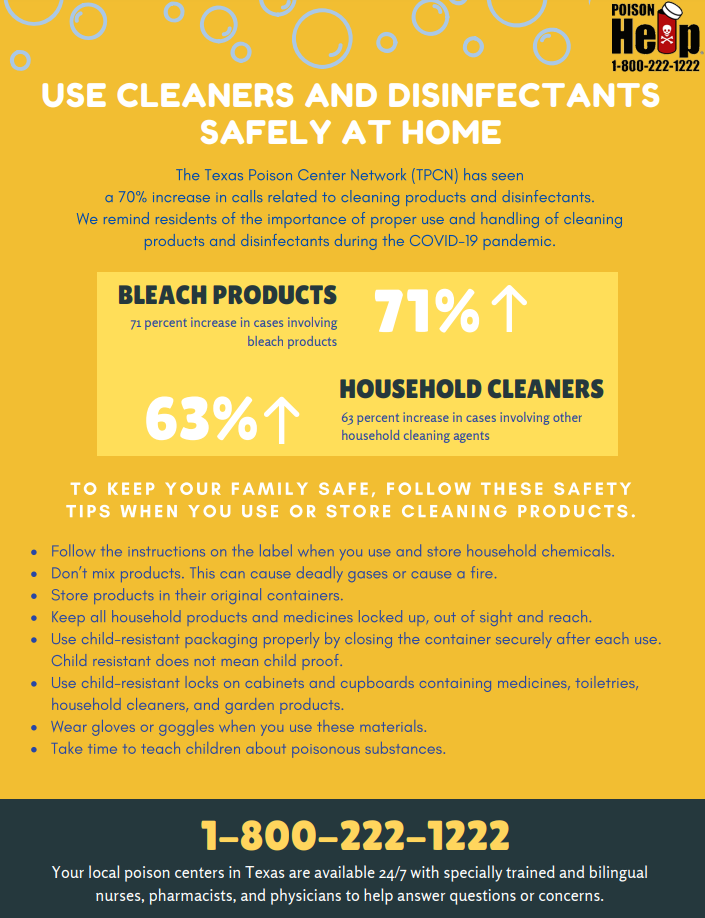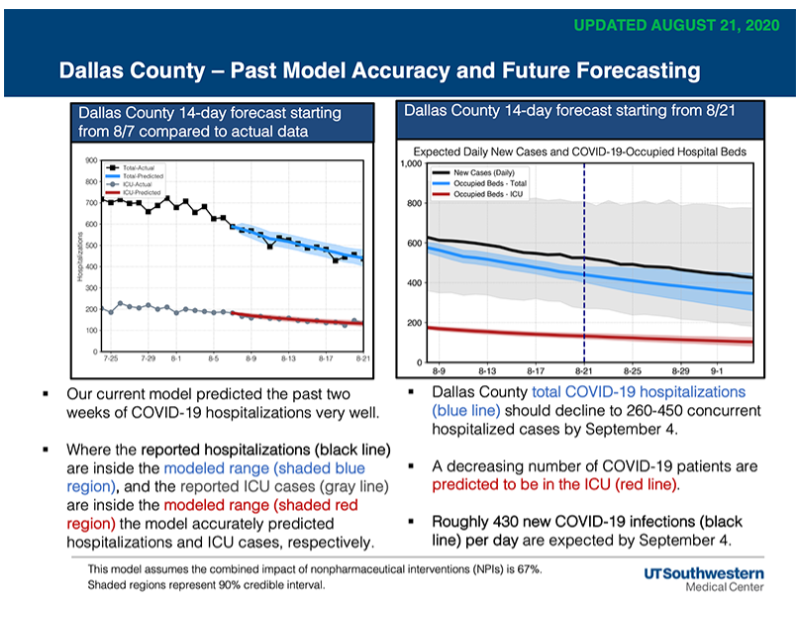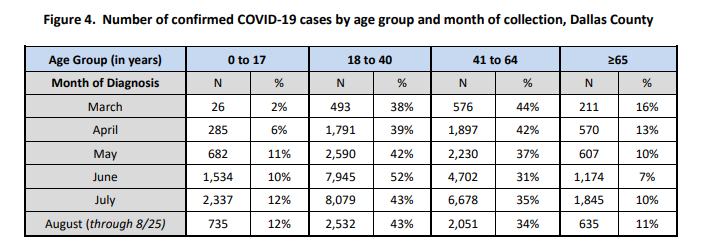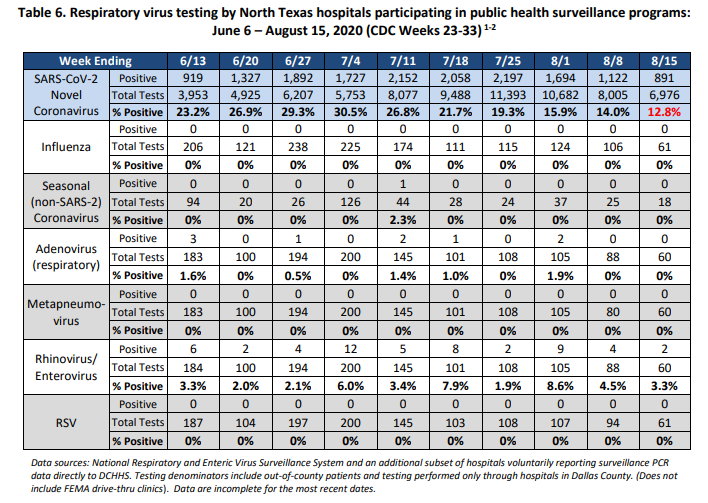Don’t Drink Bleach, North Texas Poison Center Warns
Thanks to the Internet, there is a lot of information out there about combating COVID-19 – but not all of it is reliable or even safe. Today’s digest takes a look at a warning from poison control, as well as the latest case counts from Dallas County.
- Don’t drink bleach, North Texas Poison Center warns;
- Dallas County reports 24 COVID-related deaths;
- North Texas gears up to welcome evacuees from Hurricane Laura.
Don’t Drink Bleach, North Texas Poison Center Warns
The good news? Bleach is great for cleaning high-touch areas like doorknobs, counters, and sink faucets. The bad news? Bleach is not good for combating COVID-19 inside your body.
Your guts are not a high-touch surface.

The North Texas Poison Center at Parkland Hospital said this week that 46 people have called in recently after ingesting bleach between Aug. 1 and 24.
“Ingesting bleach or other cleaning products is downright dangerous and can lead to serious injury, including burns,” the organization said, adding that “misleading and inaccurate information circulating online about how to prevent the spread of COVID-19” is to blame for the increased calls.
The FDA has warned that ingesting bleach and other disinfectants causes “severe vomiting, severe diarrhea, life-threatening low blood pressure caused by dehydration, and acute liver failure.”
Statewide, the Texas Poison Center Network said its centers have seen a 70% increase in calls regarding disinfectants and cleaning products.
Dallas County Reports 24 COVID-Related Deaths
Dallas County health officials reported 217 new confirmed cases of COVID-19 Tuesday, bringing the total confirmed case count to 69,303, including 881 confirmed deaths. The total probable cases in the county is 2,740, including eight probable deaths. None of Tuesday’s cases are from the state’s electronic laboratory system.
The county reported 24 deaths, including a Mesquite man in his 30s with no underlying high-risk health conditions, a Dallas man in his 30s, a Dallas woman in her 40s who died at a hospital emergency room, two Dallas men in their 50s, two Dallas women in their 60s, a Balch Springs man in his 60s, a Dallas man in his 60s with no underlying conditions, three Dallas men in their 60s – one without underlying health conditions, a Garland man in his 60s, a Dallas man in his 70s, two DeSoto women in their 70s, a Duncanville woman in her 70s, a Dallas man in his 70s, a Dallas woman in her 70s, a Mesquite man in his 80s, and a Dallas man in his 80s.
Long-term care facilities continue to account for roughly a third of all deaths, including a man in his 70s from a Dallas facility (he died in a hospital ER), a woman in her 70s who lived in a Dallas facility, a woman in her 80s who lived at a Lancaster facility, and a woman in her 90s who lived in a Dallas facility.
“Today we have a total of 217 new confirmed positive cases of COVID-19, none of which are from the State’s electronic laboratory reporting system,” said Dallas County Judge Clay Jenkins. “Additionally we have 24 deaths including two men in their 30s, one who did not have any underlying high-risk health conditions. We are seeing a continuing good trend in lowering numbers of infections and hospitalizations.
“We must not lose our resolve to do the things that have caused that turn in the right direction, namely masking, six-foot distancing, frequent hand washing, avoiding unnecessary trips, and avoiding any indoor activity where the people around you cannot be masked one hundred percent of the time. It’s up to all of us to combat COVID-19 and everyone must make good personal decisions for community health to be successful.”
The county said that the number of COVID-19 hospitalizations Monday was 400 patients. Emergency room visits for COVID-19 symptoms also remain high, representing about 20% of all ER visits, according to information reported to the North Central Texas Trauma Regional Advisory Council.

UT Southwestern’s latest forecast projects that by Sept. 4, Dallas County hospitals could see concurrent hospitalizations decline to between 260 and 450 cases, with roughly 430 new cases per day on average.
In the county’s Aug. 25 aggregate report, most confirmed cases continue to be between the ages of 18 and 60, with the 18-40 age group accounting for 46% of the cases, and the 41-64 age group accounting for another 34% of the total cases.

From Aug. 1-14, 531 school-aged children between 5 to 18 years of age were diagnosed with confirmed COVID-19. About 50% of these cases were high school age. By zip code of residence, 302 (57%) of these children were projected to have been enrolled in Dallas ISD schools.
The 132 children who were diagnosed between August 10-14 were projected (by zip code of residence) to be enrolled in at least 70 different schools in Dallas County. If all public schools in Dallas County had been open for full on-campus only instruction during the week of Aug. 10, the county projects that their attendance on-campus would have prompted at least 70 classroom closures for cleaning and identification of classmate/teacher contacts for 14-day quarantine.
Almost a third of all county pediatric cases were between the ages of 5 and 10. Of those cases, 302 were likely enrolled in Dallas ISD schools, and eight cases were likely enrolled in Highland Park ISD.
Close contact or community transmission continues to be the biggest risk factor for contracting COVID-19, accounting for more than 93% of all cases. Being incarcerated in a federal prison, living in a long-term care facility or being incarcerated in the county jail are a distant second, third, and fourth, at 2%, 1.9% and 1%, respectively.

Of the testing done, positive cases accounted for 12.8% as of Aug. 15, with 891 positives coming from 6,976 tests. Testing for the week prior found that positive cases accounted for 14% of all testing.
Ten percent of all cases ended up hospitalized – 23% ended up in intensive care, and 12% ended up on a ventilator.
In a city-by-city breakdown, Dallas still comes in with the highest number of cases – 36,515 confirmed cases and 1,442 probable cases. Highland Park has 62 confirmed cases (up from 59 last week) and another 17 probable cases, and University Park has 138 confirmed cases (up from 129), and 80 probable cases.
North Texas Gears Up to Welcome Evacuees From Hurricane Laura
As Hurricane Laura nears the Gulf Coast counties, the city of Dallas and Dallas County have begun working on a plan to welcome potential evacuees.
City of Dallas Office of Emergency Management Director Rocky Faz said that Dallas had been officially tasked with preparing to shelter those who are in the path of the hurricane. Dallas County issued a disaster declaration ahead of the hurricane making landfall to provide local response.
“In the event of mass evacuations from the coast, hubs have been designated in Austin, San Antonio, and Dallas to receive evacuees,” Faz said Tuesday. “Dallas has been asked to be prepared to receive guests as early as tonight or tomorrow morning. Currently, mass evacuations have not been ordered and there are no evacuees on the way yet.”
Should mass evacuations happen, the state will bus residents (with proper social distancing) to those hubs.
“The city is working with state and county partners to open the Mesquite Reception Center to accept the buses and assign non-congregate shelter locations for guests,” Faz said.
The county is also negotiating with area hotels for rooms to use, as well as meals and other wrap-around services like infection control, temperature checks, and COVID-19 testing. If air evacuations are needed, Dallas Love Field is prepared to accept those planes.
“The people coming to Dallas-Fort Worth will not be staying in group shelters, rather they will be staying in hotel rooms,” Jenkins said. “The county and city of Dallas will front the money for this expense to be 100% reimbursed by the State of Texas.”
Gov. Greg Abbott updated the press Tuesday afternoon, saying that Laura was projected to strengthen to a Category 3 or even 4 hurricane by the time it makes landfall over southeast Texas late Wednesday or early Thursday.
“Hurricane Laura is rapidly intensifying and poses a major threat to communities in Southeast Texas and along the coast,” said Abbott. “Texans in the path of this storm should waste no time preparing for the impact of Hurricane Laura and take immediate action to keep themselves and their loved ones safe. I urge our Southeast and coastal communities to heed the guidance of local officials, follow evacuation orders, and remain vigilant as we brace for the impact of Hurricane Laura. The state of Texas will continue to monitor this storm and provide the resources needed to keep Texans safe.”










